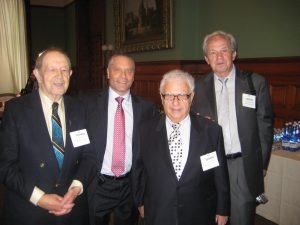No one who met French filmmaker Claude Lanzmann before he died on July 5 would describe him as warm and fuzzy. He had an intense personality, was keenly intelligent and passionately committed. He could be charming, eloquent and engaging, but there was also an abrasive edge to him. In some measure, this abrasiveness – this rejection of politesse for its own sake – was instrumental in creating his masterwork, Shoah.
The hard-hitting 1985 film, which ran for an unheard of nine-and-a-half hours, changed the future of documentaries about the Holocaust. Before Shoah, most documentaries relied on original film footage to convey the horrors of the Nazi genocide: the piles of corpses, the emaciated survivors and the well-fed SS living alongside the daily atrocities they created. But as Lanzmann understood, the visual horror created a distance. Viewers might pity the victims, but found it difficult to see themselves in them. Instead, Lanzmann harnessed the power of memory.
Well before historians began to value survivor testimonies as much as documents, Lanzmann saw memory as the way to convey the depth of horror that was the Shoah. He once termed survivors “living documents” and used their stories to relate the atrocities. Lanzmann also saw that the memories of perpetrators and bystanders – obtained by provocation, trickery and sometimes just by quiet observation – could convey the vast evil of Nazism. The filmmaker allowed a complex story to unfold through a montage of disparate and discontinuous interviews with willing and unwilling subjects, visual imagery, personal reflections, as well as staged and spontaneous scenes. After Shoah, documentaries about the Holocaust relied less and less on graphic film footage, and began trusting the voices of rememberers to resonate with viewers.
READ: HOROWITZ: EXAMINING THE PHILIP ROTH MISOGYNY DEBATE
Although the film influenced documentaries and is often referred to as one, I’ve avoided calling Shoah a documentary. Even Lanzmann rejected that term. Although he was committed to factual truth, Shoah is structured artistically. Many people have told me that while they have watched clips of the film – and been deeply affected by them – they have never watched the film as a whole. They should. Lanzmann liked to refer to Shoah as a pensée – a meditation. He wanted to do more than shock viewers with horror; he aimed to unsettle them, make them think and make them accountable.
I first saw Shoah during its initial North American release in theatres, in a screening that was spread over two days. I was stunned by its impact. One of my first thoughts afterwards was: imagine what’s on the cutting-room floor. Years later, advances in technology make it possible to find out. To make Shoah, Lanzmann filmed close to 400 hours of interviews and conversations. The outtakes – the segments that did not make it into the film – have been digitized and are available for viewing through several archives, as well as online. Lanzmann omitted material that did not fit the trajectory of the film. But the stories they tell are riveting and important. Lanzmann later utilized some of this material to create several other films.
The first of these, A Visitor from the Living (1999), focused on Maurice Rossel, a representative of the Red Cross who visited Theresienstadt in 1944 and wrote a glowing report. Lanzmann conducts a long conversation with him that gradually draws out the man’s anti-Semitic attitudes, debunking the premise that he was a neutral observer. Lanzmann came to York University in Toronto for the film’s North American release and took questions from the audience. The first question came from a man who admired the filmmaker’s self control. In the face of such damning testimony, the film showed Lanzmann listening calmly, with a neutral expression, encouraging Rossel to expose the prejudices that underwrote his glowing report to the Red Cross. “How were you able to just sit there and listen to him?” the man exclaimed. Lanzmann fixed his eye on his interlocutor and replied, “And what would you expect me to do? Take a gun and shoot him?” Instead, he shot him on camera.






